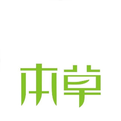Ancient Chinese medicine has a very detailed classification of diseases; even a common cold can be divided into various types such as wind-cold cold, wind-heat cold, and gastrointestinal cold. Here, we will discuss “Yin Ju“, which includes various disease types such as liuzhu (flowing abscess), hexi (crane knee), ruyán (breast lumps), luòlì (scrofula), and yǎnglump (goiter).These diseases share a common characteristic that can be understood from the term “Yin Ju”. “Ju” refers to toxic sores caused by the stagnation of qi and blood, resulting in localized swelling and hardness of the skin without color change. Yin Ju refers to sores and toxic swellings caused by “cold evil” and “phlegm-blood stasis”.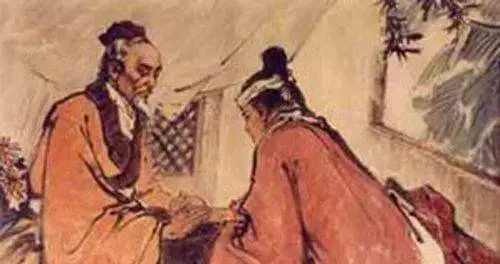 In modern medicine, “Yin Ju” corresponds to tumors, chronic ulcers, osteomyelitis, sinus fistulas, non-lactational mastitis, thyroid nodules, chronic ulcerative colitis, and many difficult-to-treat skin diseases. It is characterized by prolonged illness that is difficult to heal, initially accompanied by symptoms such as headache, fever, chills, and limb stiffness, or after ulceration, pain and fever may suddenly appear.Qing Dynasty physician Wang Hongxu stated: “Yin toxic diseases always have unchanged skin color. They can be classified as swollen or not swollen, painful or not painful, hard and immovable or soft and pliable. Are there specific prescriptions for treating these diseases?”Wang Hongxu said: Xi Huang Wan (Rhino Yellow Pill), Xiao Jin Dan (Small Golden Pill), and Yang He Tang (Yang Harmony Decoction) are all essential medicines for Yin Ju, and treating according to the prescription is foolproof. Any modifications will surely be ineffective. Here, we will take Xi Huang Wan and Xiao Jin Dan as examples.
In modern medicine, “Yin Ju” corresponds to tumors, chronic ulcers, osteomyelitis, sinus fistulas, non-lactational mastitis, thyroid nodules, chronic ulcerative colitis, and many difficult-to-treat skin diseases. It is characterized by prolonged illness that is difficult to heal, initially accompanied by symptoms such as headache, fever, chills, and limb stiffness, or after ulceration, pain and fever may suddenly appear.Qing Dynasty physician Wang Hongxu stated: “Yin toxic diseases always have unchanged skin color. They can be classified as swollen or not swollen, painful or not painful, hard and immovable or soft and pliable. Are there specific prescriptions for treating these diseases?”Wang Hongxu said: Xi Huang Wan (Rhino Yellow Pill), Xiao Jin Dan (Small Golden Pill), and Yang He Tang (Yang Harmony Decoction) are all essential medicines for Yin Ju, and treating according to the prescription is foolproof. Any modifications will surely be ineffective. Here, we will take Xi Huang Wan and Xiao Jin Dan as examples.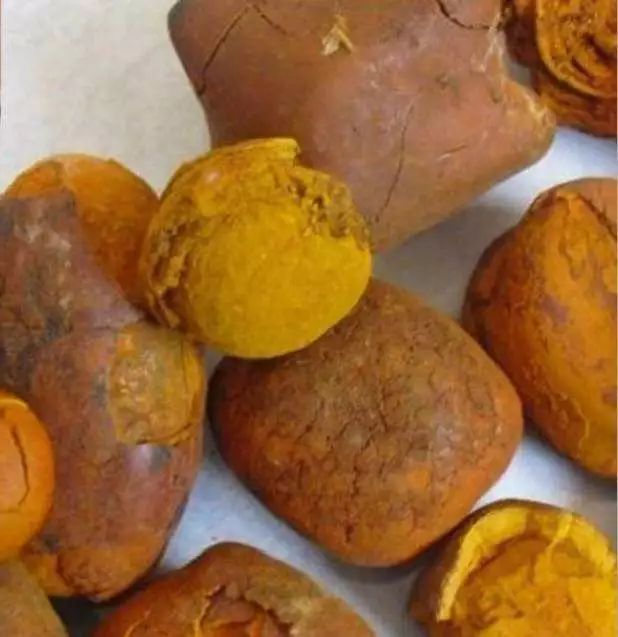 1. Xi Huang Wan, also known as Xi Huang Wan (as seen in “Therapeutic Essentials” Volume 2).Composition: Niu Huang (Bovine Bile) 0.9g, Ru Xiang (Frankincense, oil removed) 30g, Mo Yao (Myrrh, oil removed) 30g (finely ground), She Xiang (Musk) 4.5g, Huang Mi Fan (Yellow Rice) 30g.Usage: This formula is available as a prepared medicine. Dosage should follow medical advice.Indications: Ruyán (breast cancer), Hengxuan (inguinal lymphadenopathy from various sexually transmitted diseases), luòlì (scrofula), phlegm nodules, liuzhu (flowing abscess), small intestine abscess. Currently used for lymphadenitis, cystic hyperplasia of the breast, breast cancer, multiple abscesses, osteomyelitis, etc., with symptoms of red tongue and slippery, rapid pulse.The symptoms treated by this formula are often caused by heat stagnation, phlegm-blood stasis, and toxic heat accumulation. In the formula, Niu Huang clears heat and detoxifies, transforms phlegm and disperses nodules. She Xiang opens meridians, moves qi stagnation, disperses blood stasis, and resolves abscesses and toxic swellings; due to its blood-breaking and stasis-resolving effects, it is famously known as an abortion drug in palace dramas. Ru Xiang regulates qi, invigorates blood, and alleviates pain, while Mo Yao also invigorates blood, dispels stasis, reduces swelling, and alleviates pain. Huang Mi Fan nourishes stomach qi to prevent the cold and cool nature of the other herbs from harming the stomach. It is taken with wine to promote blood circulation and enhance the efficacy of the medicine.Multiple herbs work together to clear heat and detoxify, transform phlegm and disperse nodules, invigorate blood and reduce swelling, dispel stasis and alleviate pain. Clinically, it is mainly used for the treatment and adjuvant therapy of various cancers, improving clinical symptoms in patients with advanced cancer and enhancing quality of life.
1. Xi Huang Wan, also known as Xi Huang Wan (as seen in “Therapeutic Essentials” Volume 2).Composition: Niu Huang (Bovine Bile) 0.9g, Ru Xiang (Frankincense, oil removed) 30g, Mo Yao (Myrrh, oil removed) 30g (finely ground), She Xiang (Musk) 4.5g, Huang Mi Fan (Yellow Rice) 30g.Usage: This formula is available as a prepared medicine. Dosage should follow medical advice.Indications: Ruyán (breast cancer), Hengxuan (inguinal lymphadenopathy from various sexually transmitted diseases), luòlì (scrofula), phlegm nodules, liuzhu (flowing abscess), small intestine abscess. Currently used for lymphadenitis, cystic hyperplasia of the breast, breast cancer, multiple abscesses, osteomyelitis, etc., with symptoms of red tongue and slippery, rapid pulse.The symptoms treated by this formula are often caused by heat stagnation, phlegm-blood stasis, and toxic heat accumulation. In the formula, Niu Huang clears heat and detoxifies, transforms phlegm and disperses nodules. She Xiang opens meridians, moves qi stagnation, disperses blood stasis, and resolves abscesses and toxic swellings; due to its blood-breaking and stasis-resolving effects, it is famously known as an abortion drug in palace dramas. Ru Xiang regulates qi, invigorates blood, and alleviates pain, while Mo Yao also invigorates blood, dispels stasis, reduces swelling, and alleviates pain. Huang Mi Fan nourishes stomach qi to prevent the cold and cool nature of the other herbs from harming the stomach. It is taken with wine to promote blood circulation and enhance the efficacy of the medicine.Multiple herbs work together to clear heat and detoxify, transform phlegm and disperse nodules, invigorate blood and reduce swelling, dispel stasis and alleviate pain. Clinically, it is mainly used for the treatment and adjuvant therapy of various cancers, improving clinical symptoms in patients with advanced cancer and enhancing quality of life.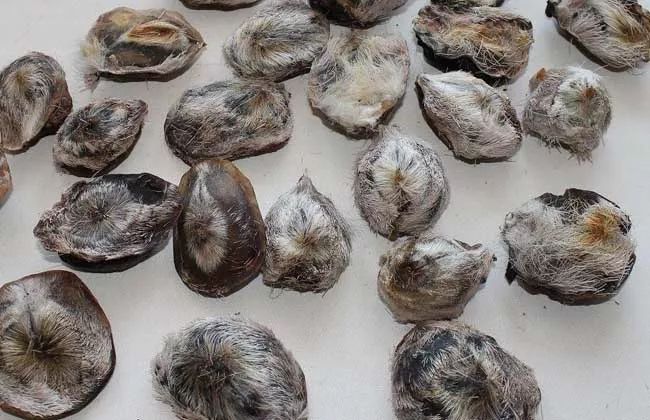 2. Xiao Jin Wan, originally called “Xiao Jin Dan”, first recorded in the Qing Dynasty by Wang Hongxu in “Complete Collection of Surgical Diagnosis and Treatment”.The complete formula consists of She Xiang (Musk) 30g, Mu Bie Zi (Tuckahoe, shell and oil removed) 150g, Zhi Cao Wu (Processed Aconite) 150g, Feng Xiang Zhi (Balsam Fir Resin) 150g, Ru Xiang (Processed Frankincense) 75g, Mo Yao (Processed Myrrh) 75g, Wu Ling Zhi (Flying Squirrel Feces, vinegar-fried) 150g, Dang Gui (Angelica) 75g, Di Long (Earthworm) 150g, Xiang Mo (Fragrant Ink) 12g.The preparation of these herbs is quite complicated, and there are proprietary medicines available in pharmacies. Dosage should follow medical advice.This formula has the effects of dispersing nodules, reducing swelling, transforming stasis, and alleviating pain. It targets symptoms caused by phlegm and qi stagnation, such as luòlì (scrofula), yǎnglump (thyroid tumors), ruyán (breast cancer), and rǔpǐ (breast hyperplasia), with symptoms of one or more lumps in the skin or beneath the skin that can be moved upon palpation, or swelling of bones and joints, with unchanged skin color and hard, painful lumps.Phlegm and qi stagnation are primarily caused by liver qi stagnation, which generates phlegm, subsequently affecting the spleen’s transport function, leading to spleen deficiency. When the spleen is deficient, it cannot transform phlegm-dampness, resulting in phlegm accumulation that is difficult to resolve, which over time can lead to the formation of lumps. Treatment requires both soothing the liver and relieving stagnation, invigorating blood and transforming stasis, and strengthening the spleen to promote dampness and phlegm transformation.
2. Xiao Jin Wan, originally called “Xiao Jin Dan”, first recorded in the Qing Dynasty by Wang Hongxu in “Complete Collection of Surgical Diagnosis and Treatment”.The complete formula consists of She Xiang (Musk) 30g, Mu Bie Zi (Tuckahoe, shell and oil removed) 150g, Zhi Cao Wu (Processed Aconite) 150g, Feng Xiang Zhi (Balsam Fir Resin) 150g, Ru Xiang (Processed Frankincense) 75g, Mo Yao (Processed Myrrh) 75g, Wu Ling Zhi (Flying Squirrel Feces, vinegar-fried) 150g, Dang Gui (Angelica) 75g, Di Long (Earthworm) 150g, Xiang Mo (Fragrant Ink) 12g.The preparation of these herbs is quite complicated, and there are proprietary medicines available in pharmacies. Dosage should follow medical advice.This formula has the effects of dispersing nodules, reducing swelling, transforming stasis, and alleviating pain. It targets symptoms caused by phlegm and qi stagnation, such as luòlì (scrofula), yǎnglump (thyroid tumors), ruyán (breast cancer), and rǔpǐ (breast hyperplasia), with symptoms of one or more lumps in the skin or beneath the skin that can be moved upon palpation, or swelling of bones and joints, with unchanged skin color and hard, painful lumps.Phlegm and qi stagnation are primarily caused by liver qi stagnation, which generates phlegm, subsequently affecting the spleen’s transport function, leading to spleen deficiency. When the spleen is deficient, it cannot transform phlegm-dampness, resulting in phlegm accumulation that is difficult to resolve, which over time can lead to the formation of lumps. Treatment requires both soothing the liver and relieving stagnation, invigorating blood and transforming stasis, and strengthening the spleen to promote dampness and phlegm transformation. The formula contains liver tonifying herbs such as Mu Bie Zi, Zhi Cao Wu, Mo Yao, Wu Ling Zhi, Dang Gui, Di Long, and Xiang Mo.Spleen tonifying herbs include Mu Bie Zi, Zhi Cao Wu, Feng Xiang Zhi, Mo Yao, Dang Gui, and Di Long.Blood invigorating and stasis-dispelling herbs include artificial Musk, Feng Xiang Zhi, Mo Yao, and Wu Ling Zhi.Swelling-reducing herbs include artificial Musk, Mu Bie Zi, Mo Yao, and Xiang Mo.Damp-dispelling herbs include Zhi Cao Wu and Di Long.Phlegm-dispelling herbs include Zhi Cao Wu and Xiang Mo.Pain-relieving herbs include artificial Musk, Zhi Cao Wu, Feng Xiang Zhi, and Mo Yao.There are even heart tonifying herbs: Dang Gui, Xiang Mo, Mo Yao, and Zhi Cao Wu.All herbs work together to tonify the heart, liver, and spleen, invigorate blood, dispel stasis, reduce swelling, dispel dampness, transform phlegm, and alleviate pain, collectively achieving the effects of dispersing nodules, reducing swelling, transforming stasis, and alleviating pain.
The formula contains liver tonifying herbs such as Mu Bie Zi, Zhi Cao Wu, Mo Yao, Wu Ling Zhi, Dang Gui, Di Long, and Xiang Mo.Spleen tonifying herbs include Mu Bie Zi, Zhi Cao Wu, Feng Xiang Zhi, Mo Yao, Dang Gui, and Di Long.Blood invigorating and stasis-dispelling herbs include artificial Musk, Feng Xiang Zhi, Mo Yao, and Wu Ling Zhi.Swelling-reducing herbs include artificial Musk, Mu Bie Zi, Mo Yao, and Xiang Mo.Damp-dispelling herbs include Zhi Cao Wu and Di Long.Phlegm-dispelling herbs include Zhi Cao Wu and Xiang Mo.Pain-relieving herbs include artificial Musk, Zhi Cao Wu, Feng Xiang Zhi, and Mo Yao.There are even heart tonifying herbs: Dang Gui, Xiang Mo, Mo Yao, and Zhi Cao Wu.All herbs work together to tonify the heart, liver, and spleen, invigorate blood, dispel stasis, reduce swelling, dispel dampness, transform phlegm, and alleviate pain, collectively achieving the effects of dispersing nodules, reducing swelling, transforming stasis, and alleviating pain. According to Menghe physician Ma Peizhi:“This pill dispels phlegm and transforms dampness, effectively unblocking the meridians,” which is highly favored by physicians throughout history and is now widely used in the treatment of breast, thyroid, and prostate diseases. Professor He Xiulan from Beijing University of Chinese Medicine believes: Currently, the clinical application of Xiao Jin Dan is very broad, especially suitable for breast cancer. In my practice for breast cancer, Xiao Jin Dan is often the first choice among prepared medicines.The original formula also mentions that Xiao Jin Dan can treat early-stage ruyán, and through online verification, it has been found that some people have effectively used Xiao Jin Dan to treat early-stage breast cancer, while others have not seen significant effects. The following image is a screenshot of comments from the Chinese Journal of Traditional Chinese Medicine’s public account:
According to Menghe physician Ma Peizhi:“This pill dispels phlegm and transforms dampness, effectively unblocking the meridians,” which is highly favored by physicians throughout history and is now widely used in the treatment of breast, thyroid, and prostate diseases. Professor He Xiulan from Beijing University of Chinese Medicine believes: Currently, the clinical application of Xiao Jin Dan is very broad, especially suitable for breast cancer. In my practice for breast cancer, Xiao Jin Dan is often the first choice among prepared medicines.The original formula also mentions that Xiao Jin Dan can treat early-stage ruyán, and through online verification, it has been found that some people have effectively used Xiao Jin Dan to treat early-stage breast cancer, while others have not seen significant effects. The following image is a screenshot of comments from the Chinese Journal of Traditional Chinese Medicine’s public account: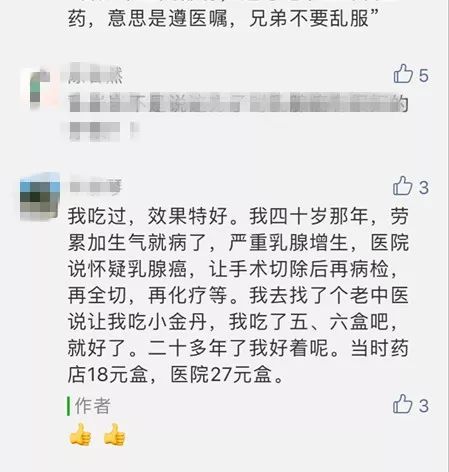 Reflecting on Wang Hongxu’s words: Treating according to the prescription is foolproof. Any modifications will surely be ineffective. He also stated, “The formula contains Wu Ling Zhi, which should not be taken with Ren Shen (Ginseng), Gao Li Shen (Korean Ginseng), or Dang Shen (Codonopsis) on the same day.” Could it be that patients have altered the dosage during use or even taken ginseng, Dang Shen, etc. simultaneously? It is unknown. Additionally, the condition of ruyán is related to emotional state, so the patient’s mood may also affect the efficacy!When comparing Xi Huang Wan and Xiao Jin Dan, it is clear that: Both have detoxifying effects, with Xiao Jin Wan leaning towards dispelling cold toxins and Xi Huang Wan leaning towards dispelling heat toxins. Regarding certain medication contraindications, Professor He Xiulan believes: Theoretically, both Xi Huang Wan and Xiao Jin Dan should be used for excess conditions, and deficiency conditions are not advisable. However, for tumor patients, one need not be overly strict about the manifestations of cold and heat conditions; the range of medication can be broader.Reminder: Everyone’s physical condition is different; the formulas provided in this article should be adjusted according to individual conditions. It is recommended to seek guidance from a professional physician. (Images from the internet; please contact for removal if there is any infringement.)
Reflecting on Wang Hongxu’s words: Treating according to the prescription is foolproof. Any modifications will surely be ineffective. He also stated, “The formula contains Wu Ling Zhi, which should not be taken with Ren Shen (Ginseng), Gao Li Shen (Korean Ginseng), or Dang Shen (Codonopsis) on the same day.” Could it be that patients have altered the dosage during use or even taken ginseng, Dang Shen, etc. simultaneously? It is unknown. Additionally, the condition of ruyán is related to emotional state, so the patient’s mood may also affect the efficacy!When comparing Xi Huang Wan and Xiao Jin Dan, it is clear that: Both have detoxifying effects, with Xiao Jin Wan leaning towards dispelling cold toxins and Xi Huang Wan leaning towards dispelling heat toxins. Regarding certain medication contraindications, Professor He Xiulan believes: Theoretically, both Xi Huang Wan and Xiao Jin Dan should be used for excess conditions, and deficiency conditions are not advisable. However, for tumor patients, one need not be overly strict about the manifestations of cold and heat conditions; the range of medication can be broader.Reminder: Everyone’s physical condition is different; the formulas provided in this article should be adjusted according to individual conditions. It is recommended to seek guidance from a professional physician. (Images from the internet; please contact for removal if there is any infringement.)
